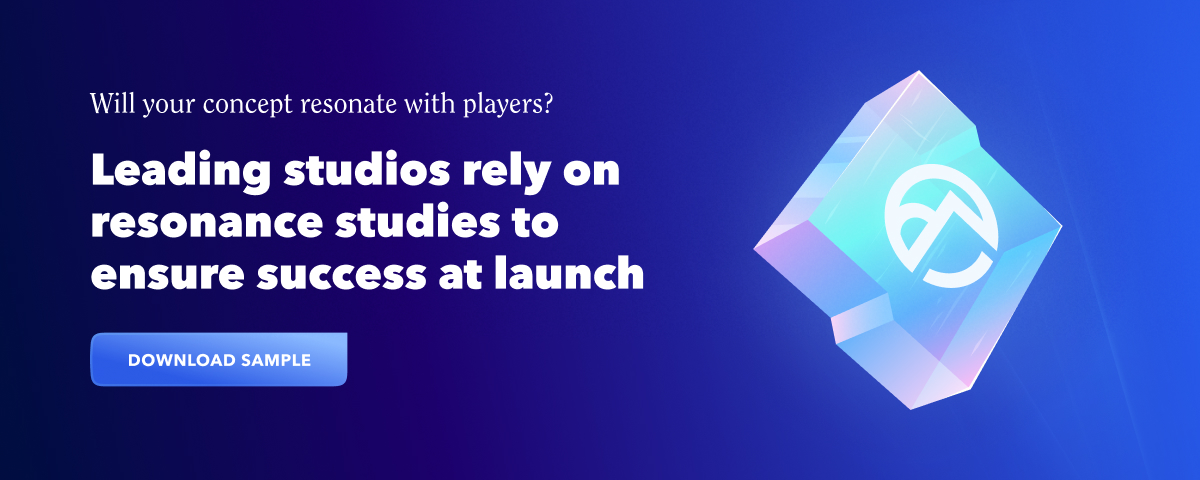Waiting to get game feedback from players later in the development stage can lead to longer development timelines when you realize the game you made isn’t hitting the mark for your target audience. Investing in research methods early in your game development let’s you gather feedback early when there is time to iterate and act on the feedback, saving time and resources down the line.
One of the best early research methods to understand if your game has strong market potential is resonance testing your game concept against your target audience.
We talk to Bilge Coskun, User Experience Research Lead at Solsten and former UX researcher at leading studios like Ubisoft and Tactile Games, who has been building successful player-centric experiences. She talks about her experience using research to solve common problems for game teams to ensure their game idea is a success at launch and why resonance testing is king when it comes to validating your game’s market potential early on in development
Q: What traditional problems do game teams encounter when trying to understand what type of game or new feature will fit their target market that research can help solve for?
Creating games that resonate with players requires more than just technical mastery and artistic flair. The challenge often lies in understanding the rapidly shifting and evolving player base—knowing who the gamers are, what they expect, and their preferences—is where challenges frequently arise.
One major hurdle is the lack of sufficient knowledge of the player base. Regardless of the game’s novelty, whether it’s a fresh indie concept or a new addition to a blockbuster series, there’s always a question mark over who the players are, how well the game will resonate with the target audience or the game’s potential to attract new segments. It’s akin to navigating a dark room; mastery in development means little if you don’t have a good understanding of the actual people who will play your game, which can lead to potential missteps.
On the flip side, some teams might fall into the trap of assuming they know exactly what their players want. This overconfidence can lead to focusing on the wrong or very limited segment of their audience, a lack of innovation or the recycling of old ideas, under the guise of giving players what they supposedly prefer. The danger here is not just stagnation but also alienating or misjudging players. Relying too heavily on rigid assumptions about surface-level player behaviour, without delving into the depth of who they truly are, can unveil numerous unforeseen challenges on the horizon, much like being blinded by bright sunlight.
And from whichever direction and to what degree you encounter this problem, failing to invest enough time and resources into understanding and engaging with the player base, often leads to poor market performance and negative player feedback, leading to increased costs for fixes and improvements. What you need is just enough sunlight to illuminate the shadows and mitigate the glare—enough data and insight to navigate the complexities of player preferences without being overwhelmed or misguided by them. Effective games user research can help with exactly this, revealing both the clear path forward and the hidden pitfalls.
Q: What traditional methods of research have you conducted or seen for new game or product launches? What has worked well and what has not worked?
Each step of development can call for different methodologies. When a game is in the ideation or prototyping stage, we often try to understand how potential players will receive it and how similar titles, if any, are performing in the market, what they excel at, and where they fall short. You can gain insights on these aspects through early concept testing, competitor analysis, and targeted user experience surveys. This way, you can tailor your game to better meet the expectations of your target audience, anticipate market trends, and position your game strategically among competitors.
For a new game that has advanced in development without significant investment in research at the earlier stages, that’s when problems typically begin to surface. When you start conducting the research later in the production and unless you are extremely lucky, no kind of market research or playtesting will save you from the high costs and delays associated with making significant changes to core game mechanics or concepts already deeply embedded into the game. The earlier you start planning and integrating your research plan into your development roadmap, the more room you have for adjustment. An example of how to achieve this would be the iterative testing of game mechanics, which can significantly refine gameplay based on user feedback before finalizing the product.
Another common mistake I often observe is playtesting to measure appreciation for game builds or prototypes that have too many usability and technical issues. You can’t expect to test a broken leaky glass with the user and get solid answers to how enjoyable their experience was. We aim to resolve these basic issues before moving on to test the game for its enjoyment. Otherwise, we frequently find that the feedback is rooted more in technical issues than in the game loop or mechanics. I understand that teams are eager to showcase their product to players or may sometimes face time constraints. In such cases, we suggest prioritizing usability-focused tests and opting for concept/resonance testing to measure the appreciation of art assets, features, and mechanics.
Q: What are the challenges that large companies face when creating a new game, even if you have really good player data?
Even with robust behavioral data, understanding the deeper motivations and personality traits of players can be challenging. While behavioral data can provide insight into what players are doing, it falls short in explaining why they engage in certain behaviors. This lack of depth can lead to misinterpretations of what players truly want or need from a game. Without insights into the underlying motivations and personality traits, companies may miss out on crafting game experiences that genuinely resonate with their audience, leading to games that may perform well initially but fail to retain a loyal user base over time. Another common issue I observed is cherry-picking the data that supports pre-existing hypotheses or desired outcomes. This selective use of data can create a biased understanding of player needs and preferences, leading to decisions that may not be in the best interest of the broader player base. It can also cause the development team to focus on unnecessary or less in-demand features, consequently misaligning the game’s direction with the actual market needs.
Q: Would you recommend doing Resonance Testing over other research methods when developing a new game?
Absolutely! Let me explain with an example. Imagine two players who enjoy similar types of games and share similar demographics. One is a fearless extrovert who eagerly embraces new experiences and maintains low levels of stress and anxiety in their daily life. Now, picture the second player as a true empath who doesn’t particularly seek out social experiences but instead finds solace in fantasy-based content that ignites their imagination and helps alleviate the anxiety they face in their everyday lives. How might these two players differ in their preferences for game mechanics, visual design, art style, narrative, and other aspects of the game? Traditional concept testing won’t provide answers to these questions, as it often fails to recognize the differing traits of human beings and how these traits impact their gaming experience. Is it possible to create a game design that provides both of these players with an equally satisfying experience? Alternatively, should we prioritize one player’s preferences over the other? If we do prioritize, what indicators can we use to determine which player might benefit more from the game?
A resonance study addresses these questions by providing game companies with deep insights early in their conception phase. This type of testing explores how different aspects of a game resonate with various player personas based on their psychological traits and personal preferences, rather than just demographic or behavioral data. This approach not only saves time and resources but also ensures that the game design is fine-tuned to appeal to its intended audience, which enhances player satisfaction and engagement. Thus, resonance testing is invaluable for creating more targeted and successful games that truly connect with players on a deeper level.
With Solsten’s resonance study reports, you get quality actionable insights from your actual target audience early in the development process so you can build your game concept with confidence.
Q: What is the ultimate advantage for research teams who leverage Solsten’s data?
The current practice of recruiting participants for games user research studies typically involves selecting players based on demographics and the gaming preferences. However, this approach overlooks many important factors and conflicting/differing feedback regarding player experience gets tough to explain. Such discrepancies in feedback is often rationalized with player taxonomies that are either outdated or not sufficiently detailed to address the complexities of the gaming world. In contrast to these rigid taxonomies, Solsten’s persona clustering is tailored to each specific game and genre. What Solsten’s data provide research teams is an in-depth understanding of the player, which they can use to interpret behavior beyond mere observations for each persona. This approach not only helps in targeting the right audience for your playtests based on their traits but also adds a second layer of data atop behavior and appreciation metrics. This brings about rich and unique insights and increases the reliability of research results.




